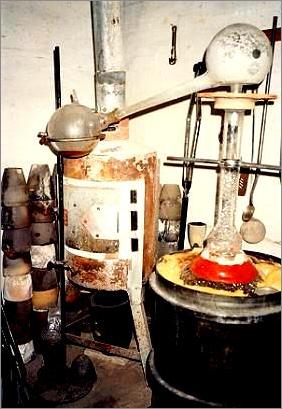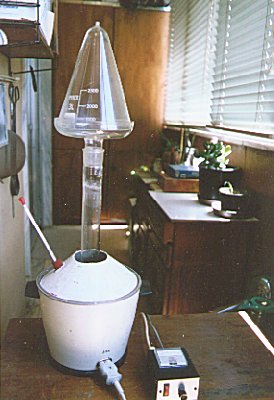Salt of Urine
Here it is, one of the great arcana of the
alchemical spagyrics that only a few artists know, sought by many and which, now, to help
you, we have put within your reach.
Van Helmont, a great spagyrist converted to
alchemy, refers to this salt, also known as volatile alkali, as the base of the
preparation of the Alkahest.
The volatile salt of urine is, basically,
ammonium carbonate. It may seem to you purposeless and possibly repugnant, in the end of
the 20th century, to extract this salt of urine, when you can acquire it easily in a store
of chemical products.
As we already have said, and we didn't get tired
of repeating it, the salts used in alchemy, if they are to be canonical, they should be,
so much as possible, of native (natural) origin, just as our Masters used them, because
actually, a great part of the existent chemical products on the market are synthetic, and
they don't have, under the alchemic point of view, the same characteristics of the native
salts.
Here it is brothers, the reason why some ignorant
people stupidly denigrate our Art.
From urine there are extracted two salts
basically, of which the alchemists made wide use: the volatile ammonium carbonate, and the
fixed salt or ammonium chloride. The chloride can be extracted, also, from the volatile
salt.
To prepare the volatile salt, you will need more
than 60 litres of urine coming from ruminant animals or from a human being.
For many, it would be an impossible work to
extract the phlegm of the putrefied urine and to sublimate the dregs, it being an annoying
work due to the pestilential smell that exhales from the putrefied liquid excretion. So,
we will explain to you a mixed method, just as we did with the nitre revivification.
Acquire 1 kg of rough ammonium sulphate, as used
in agricultural fertilizer. Dissolve it in 1 litre of water heated up to 40°C, in a glass
or stainless steel bowl.
Dissolve, in the same way, in a litre of water
and in another similar bowl, 1 kg of commercial sodium carbonate or, better still,
canonical tartar salt (potassium carbonate) extracted from the vine, of oak or of the
tartar of wine.
Pour the carbonate solution into the 6-litre
cucurbit of a 6-litre alembic the same as that used for the spirit of wine distillation.
Pour, slowly, in the carbonate solution, and the
whole ammonium sulphate solution. Seemingly, no chemical reaction will be noticed, but it
happens that a double chemical decomposition happens, which results in the production of
ammonium carbonate.
Connect the helm to the recipient and distil at a
temperature that does not exceed 80°C, on a suitable electric oven with controlled
temperature.
It will distil into the recipient a thick and
transparent liquid like tartar oil that smells much of ammonia that will make your eyes
tear, if you breathe it. This is a liquid ammonium carbonate. Just distil, 1 litre of that
oil.
Some volatile salt will adhere to the interior of
the helm, so when you have just distilled 1 litre, remove the helm of the cucurbit and,
remove from the inside of the helm the volatile salt, that you will add to that which you
distilled.
With care, pour 5 litres of urine into a 5 litre
large plastic bottle and close it well so as not to exhale the bad smell. Let tit putrefy
well, then you will notice the dark colour that it acquires and the nauseous smell that
exhales, when you uncover the bottle.
Pour 4 litres of that urine in another large
plastic bottle and join to it 1 litre of your distilled oil. Let everything putrefy for 10
days or more.
Order from a glass blower, a special aludel for
sublimation. This aludel will be made of a 3-litre Erlenmeyer, cut around its girth 2 cm
above the base. The upper part of the vase will be a closed in cone having in its top a
capillary air hole.

In the centre of the base a IN45 male joint will
be placed, that will fit in the IN45 female joint, as you can observe in the respective
picture.
The cone should fit neatly on top of this base.
To close the aludel tight, a rubber ring should be placed around the whole girth of the
glass cone. This cone will be safely fixed to the base by two crossed rubber bands.
In the same 6 litre alembic, pour into the
cucurbit the 5 litre mixture, apply the 40cm extension that you know of already, with an
IN70 male joint on one extremity and a female IN45 on the other, as used for the spirit of
wine rectification. Place in it the sublimation aludel, the one that we already referred
to, take care to apply silicon on all the joints.
Heat up slowly, until you reach 60°C, and leave,
like this, for 3 days. The volatile salt of urine will begin to sublime in the cone of the
aludel, and it will fill completely its inner wall.
If after some hours you don't observe the
salt's sublimation, then increase the temperature a little more, until the sublimate
appears.
When you see that the layer of salt inside the
cone of the aludel doesn't increase any more in thickness, then stop and turn off the
oven.
Disassemble the aludel and remove gently, with
the point of a stainless steel knife, so as not to break the glass cone, the salt that one
finds crystallized in layers. The salt emanates a very strong smell to ammonia. Don't
breath the fume of the salt, because you will feel the same unpleasant symptoms of the
ammonia smell. Keep this in a large mouth glass flask very well closed, sheltered from the
light.
Here we have, then, volatile canonical urine
salts corresponding to more than 100 litres of urine, from having been fermented in the
environment from which it originates. The test of this is that the salt emanates, still, a
slight smell the urine.
If it is necessary, you can purify it, dissolving
it in rainwater or distilled dew and, for the same process, sublimate it again, until that
is pure and as white as ice.
Aludel:

Rubellus Petrinus
@nifo@innergarden.org
Inner Garden Foundation
P.O. Box 8520, 3542AD
Utrecht, The Netherlands